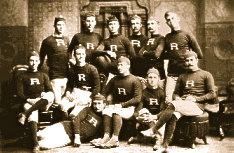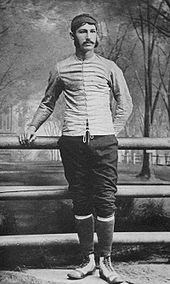College Football

Oldest College Football Game Princeton and Yale 1903

Princeton and Yale’s 1903 battle wasn’t just a match-up of undefeated teams. It also served as the site for the oldest collegiate football video footage on record, thanks to a Thomas Alva Edison-sponsored production company. The result is a remarkable recording of a game previously witnessed by only the 50,000 spectators on hand.
College football refers to American football played by teams of student athletes fielded by American universities, colleges, and military academies, or Canadian football played by teams of student athletes fielded by Canadian universities. It was through college football play that American football rules first gained popularity in the United States.
First American college football game – Main article: First football game ever played
The Rutgers College football team in 1882.
The first ever intercollegiate football game between two American teams played under rules which would eventually become the rules under which modern American football is governed occurred between Princeton and Rutgers University in 1869. The completion of the first ever American football season came as a result of only two total games being played.
A game which modern audiences would more readily recognize as American football occurred six years after the first ever game and occurred between Harvard University and Tufts University on June 4, 1875. The first game ever played that resembles the game as it is known today was played between an American team, Harvard, and a Canadian team, McGill University of Montreal in 1874. Harvard, who was trying to get away from the soccer like game that many schools played, set out to find another school who played a game similar to them. This first game was a lot like rugby but much closer to the modern day version of football than soccer. After the captains of the two teams met they quickly realized that the games each school played were still different. In a compromise the teams decided to play two different games, one under each teams set of rules. On May 14, Harvard won the game under their rules, and the game on the following day, May 15, under McGill’s rules ended in scoreless tie. Harvard would eventually go on to fully adopt the McGill version of the game that included more carrying of the ball and also used an oblong ball that was easier to carry and throw. An 1869 game of intercollegiate “football” between Rutgers and Princeton is often cited as the first intercollegiate American football game, however it was an unfamiliar ancestor of today’s college football, as it was played under 6-year-old soccer-style Association rules. The game played between teams from Rutgers University and Princeton University, which was called the College of New Jersey at the time, took place on November 6, 1869 at College Field, which is now the site of the College Avenue Gymnasium at Rutgers University in New Brunswick, New Jersey. Rutgers won by a score of 6 “runs” to Princeton’s 4. The 1869 game between Rutgers and Princeton is important in that it is the first documented game of something called intercollegiate “football” ever played between two American colleges, and because of this, Rutgers refers to itself as The Birthplace of College Football. It came two years before an inter-club rugby game under the auspices of the Rugby Football Union would be played in England; though it must be remembered that rugby had been codified 24 years before this in 1845 and played by many schools, universities and clubs even before the laws were first put on paper. Although the Rutgers-Princeton game was undoubtedly different from what we today know as American football, it was the forerunner of what evolved into American football. Another similar game took place between Rutgers and Columbia University in 1870. The popularity of intercollegiate competition in football would spread throughout the country.
Rugby is adopted by American colleges
Yale, together with Rutgers, Princeton and Columbia met on October 20, 1873 at the Fifth Avenue Hotel in New York City to agree a set of rules and regulations that would allow them play a form of football that was essentially Association football (today often called “soccer” in the US) in character. Harvard University turned down an invitation to join this group because they preferred to play a rougher version of football called “the Boston Game” in which the kicking of a round ball was the most prominent feature though a player could run with the ball, pass it, or dribble it (known as “babying”). The man with the ball could be tackled, although hitting, tripping, “hacking” (shin-kicking) and other unnecessary roughness was prohibited. There was no limit to the number of players, but there were typically ten to fifteen a-side.
Harvard’s decision not to join the Yale-Rutgers-Princeton-Columbia association meant that they needed to look further afield to find football opponents so when a challenge from Canada’s McGill University rugby team in Montreal was issued to Harvard, they accepted. It was agreed that two games would be played on Harvard’s Jarvis baseball field in Cambridge, Massachusetts on May 14 and 15, 1874: one to be played under Harvard rules, another under the stricter rugby regulations of McGill. Harvard beat McGill in the “Boston Game” on the Thursday and held McGill to a 0-0 tie on the Friday. The Harvard students took to the rugby rules and adopted them as their own, travelling to Montreal to play a further game of rugby in the Fall of the same year winning by three tries to nil.
Harvard then played Tufts University on June 4, 1875, again at Jarvis Field. Jarvis Field was at the time a patch of land at the northern point of the Harvard campus, bordered by Everett and Jarvis Streets to the north and south, and Oxford Street and Massachusetts Avenue to the east and west. The game was won by Tufts 1-0 and a report of the outcome of this game appeared in the Boston Daily Globe of June 5, 1875. In this game each side fielded eleven men, participants were allowed to pick up the inflated egg-shaped ball and run with it and the ball carrier was stopped by knocking him down or “tackling” him. A photograph of the 1875 Tufts team which hangs in the College Football Hall of Fame in South Bend, Indiana commemorates this match as the generally accepted first intercollegiate football game between two US institutions.
In 1876 at Massasoit House in Springfield, Massachusetts, Harvard persuaded Princeton and Columbia to adopt an amalgam of rugby’s laws and the rules that they were then playing, thus forming the Intercollegiate Football Association (IFA). Yale initially refused to join this association because of a disagreement over the number of players to be allowed per team (relenting in 1879) and Rutgers were not invited to the meeting. The rules that they agreed upon were essentially those of rugby union at the time with the exception that points be awarded for scoring a try, not just the conversion afterwards (extra point). Incidentally, rugby was to make a similar change to its scoring system 10 years later.
Rugby becomes American Football
 Walter Camp, the “Father of American Football”, pictured here in 1878 as the captain of the Yale Football team
Walter Camp, the “Father of American Football”, pictured here in 1878 as the captain of the Yale Football team
Walter Camp, known as the “Father of American Football”, is credited with changing the game from a variation of rugby into a unique sport. Camp, who was a rugby coach, decided to come up with a new set of rules to create a game that was completely different. Camp is responsible for pioneering the play from scrimmage (earlier games featured a rugby scrum, and was also the one who decided that teams should have four downs to advance the ball ten yards. Camp was also responsible the eleven-man team. Camp also had a hand in popularizing the game. He published numerous articles in publications such as Collier’s Weekly and Harper’s Weekly, and he chose the first College Football All-America Team.


